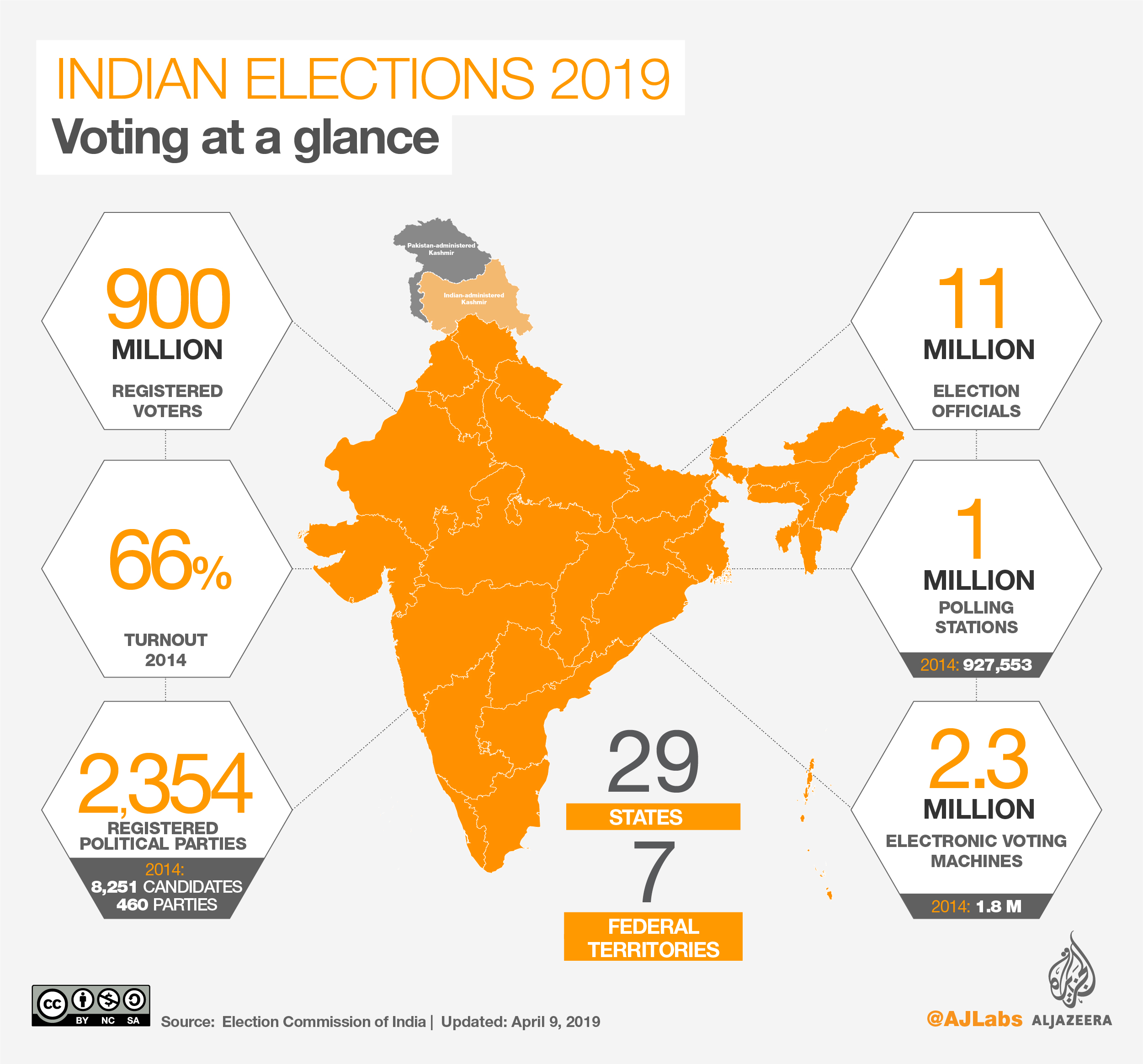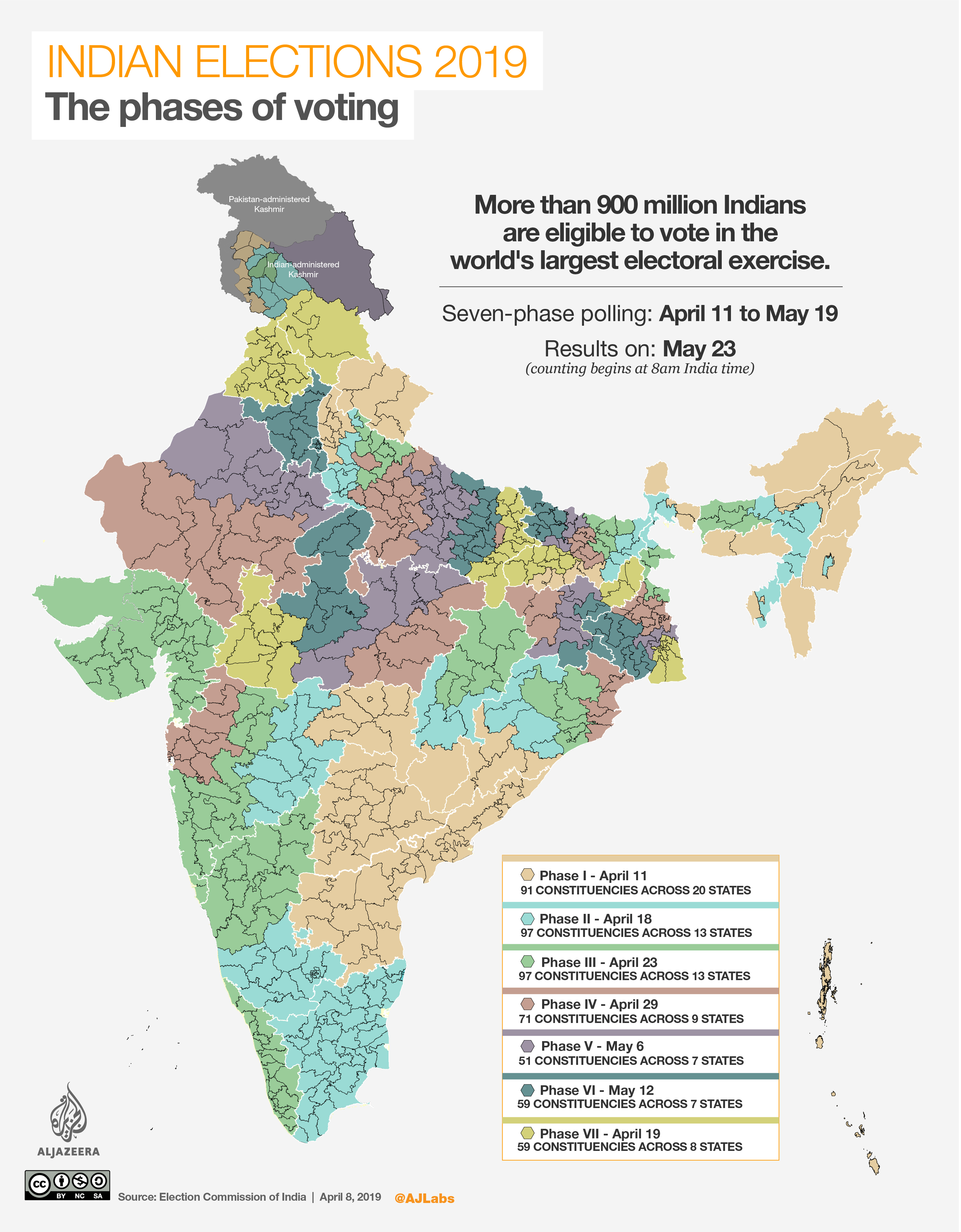India‘s multi-phase general elections kick off on Thursday when millions will vote in 91 constituencies across 20 states and federal territories in the first phase of the polls.
Approximately 900 million voters – more than the combined population of the United States and the European Union– are eligible to participate in the world’s biggest electoral exercise.
|
Indian elections: World’s biggest democratic election explained |
The seven-phase elections will conclude on May 19. Results will be announced on May 23.
Voters from across 29 states and seven federally-administered territories will elect 543 members to the lower house of parliament called the “Lok Sabha” or House of the People over the course of more than a month.
The party or coalition with a simple majority (273 seats) is invited to form a government. The MPs from the winning party or coalition elect their leader who then becomes the country’s prime minister.
At least 2,354 political parties are registered with the Election Commission of India – an autonomous constitutional body – for the 17th House of the People elections. However, only around 500 of them are expected to field candidates.
In the 2014 elections, 8,251 candidates from more than 460 political parties contested the elections.
Elections will also be held for the states assemblies in Andhra Pradesh, Arunachal Pradesh, Odisha and Sikkim.
 |
More than 11 million election officials, including security forces, will be deployed across more than one million polling stations to “conduct the biggest management event of any kind”.
“We have been conducting the largest elections in the world every time with great credibility,” Shahabuddin Yaqoob Quraishi, the former Chief Election Commissioner (CEC), told Al Jazeera.
“It’s the most powerful electoral body in the world, that’s why have been able to conduct the biggest management event of any kind with such finesse every time,” Quraishi said.
More than 450 officers and staff work at the Election Commission’s headquarters in the capital New Delhi.
Election officials and security forces travel by foot, road, trains, helicopters, boats and sometimes elephants to reach remote areas.
In the 2009 general election, a polling station was set up in the Gir forest of western Gujarat state just for one voter.
India is home to about half a million transgender people, who were recognised by the Supreme Court in 2014. Approximately 39,000 voters have been identified as “third gender”.
About 38.7 billion rupees ($552m) was spent to conduct the 2014 elections, according to the Election Commission estimates.
 |
Voting in India is conducted by electronic voting machines or EVM, which was first introduced in 1982. More than 2.3 million EVMs will be used in 2019 elections as compared with 1.8 million ones in 2014.
To check for foul play, vehicles transporting the EVMs will be fitted with GPS devices to monitor their movements.
The EVMs allows vote counting to be completed in up to three hours compared with manual counting, which could take 30 to 40 hours.
The electoral body also uses digital cameras, videotaping of speeches and the use of wireless networks during the election process.
In the current elections, Voter Verifiable Paper Audit Trail (VVPAT) machines will be used along with EVMs at all polling stations after opposition parties questioned the EVMs’ accuracy.
The VVPAT allows the voter to cross-check the votes.
“Ever since EVMs were introduced in 1982, they have been questioned and challenged, but they have stood judicial scrutiny and they stood the test of time,” Quraishi, the former electoral body chief said.
“Now finally we have introduced VVPAT, which means a paper slip is generated, which you can use to crosscheck the figures in the machines.”
 |
About 553 million, or 66 percent, of all eligible voters turned out in the last election that gave Hindu nationalist politician Narendra Modi a landslide victory – the first absolute majority in three decades.
But critics say that India’s electoral process should also address allegations of voter fraud in some parts of the country and work to minimise vote-buying during the campaign.
“Money power has been a major problem in the last couple of decades. There are legal mechanisms on expenditure by candidates but they are violated with impunity because there’s a lot of black money. EC does not have a magic wand to remove black money from the elections,” Quraishi said.
“Electoral bonds were introduced to bring transparency but they have achieved exactly the opposite since donors to political parties are not known to the public.”
Electoral bonds are promissory notes that allow anonymous, digital donations to registered political parties.
“The solution is simple,” the former CEC Quraishi said. “Let the bond continue, but there should be disclosure who has donated to whom so that people can form their own opinion whether there is quid pro quo or whether it’s a case of crony capitalism.”
Due to cheap data tariffs, India is home to the biggest markets for social media platforms such as Facebook and WhatsApp.
To check the misuse of social media, candidates are required to declare their social media accounts.
Facebook and Google have promised not to allow malicious content on their platforms and will report fake news and hate speech to the election commission.
 |
The main issues
National security has dominated the election campaigning in the wake of a military standoff with neighbouring Pakistan following a suicide attack in Indian-administered Kashmir.
Prime Minister Narendra Modi, who is seeking re-election, has used national security and a promise to build a temple for the Hindu god Ram to galvanise his Hindu support base.
In the past five years under the Bharatiya Janata Party (BJP) government, social tensions have gone up due to attacks on minority groups such as Dalits and Muslims.
The opposition parties, including the Congress party, have questioned the government’s handling of the job crisis – the worst in 45 years – and agrarian distress.
Modi’s main challenger, Rahul Gandhi of the Indian National Congress party has promised minimum income job guarantee (6,000 rupees or $87 a month) for the poorest 20 percent of the population.
Though a number of Indian cities have been included in the most-polluted list, pollution has failed to become an election issue.
Female representation in House of the People has been low despite India electing a woman prime minister, Indira Gandhi, in 1966. In the outgoing lower house, only 59 lawmakers were female.
India is home to 172 million Muslims, who are underrepresented in its democratic institutions. In the last parliament, only 22 MPs were Muslims – the lowest since India conducted its first elections in 1952.
Major leaders
- Narendra Modi – incumbent prime minister and BJP leader
- Rahul Gandhi – leader of the main opposition Congress party
- Mamata Banerjee – chief minister of West Bengal state and leader of the Trinamool Congress
- Akhilesh Yadav – leader of Samajwadi Party and former Uttar Pradesh chief minister
- Mayawati – leader of Bahujan Samaj Party and former Uttar Pradesh chief minister
- Tejashwi Yadav – leader of Rashtriya Janata Dal and former deputy chief minister of Bihar state
- MK Stalin – leader of Dravida Munnetra Kazhagam party from Tamil Nadu
- Navin Patnaik – chief minister of Odisha state and the leader of Biju Janata Dal
- Shashi Tharoor – the leader of the Congress party and a former minister
- Pinarayi Vijayan – chief minister of Kerala state and the leader of Communist Party of India (Marxist)
- Asaduddin Owaisi – one of the most prominent Muslim leaders of the country, the leader of All India Majlis-e-Ittehadul Muslimeen (MIM)
- Nitish Kumar – chief minister of Bihar state and the leader of Janata Dal (United)
 |
Source: Al Jazeera




